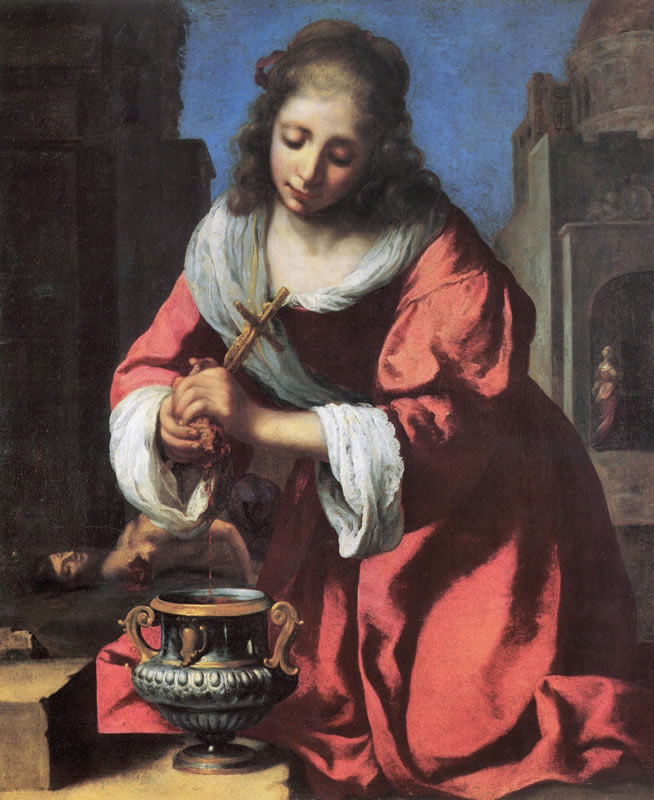Except for the images with the sponge, the two saints do not have a consistent iconography, nor is there any consistency in the portraiture. In the 11th-century frieze above the main portal at Santa Pudenziana they wear crowns and carry flaming lamps, an allusion to the parable of the wise and foolish virgins (Matthew 25:1-13).
In a fresco in the same church they wear small white scarves and present their crowns to the Virgin and Child. Crowns also appear in the 9th-century apse at Santa Prassede, where the two saints are twice shown offering their crowns to Christ and also joining the procession of martyrs who bring their crowns to the Heavenly Jerusalem. Apparently their crowns speak to their diligence in caring for the bodies of the martyrs: In most Christian iconography only martyrs bear crowns.
Prepared in 2015 by Richard Stracke, Emeritus Professor of English, Augusta University

Vermeer, Saint Praxedes, 1655 (See description page)
MORE IMAGES
- 9th century: In the Chapel of St. Zeno at St. Praxedes in Rome, one mosaic of the sisters with St. Agnes and another of two saints, possibly Praxedes and Pudentiana, flanking the enthroned Virgin and Child.
- 16th or 17th century: In Rosetti and Zuccari's Saints Praxedes and Pudentiana Bury the Martyrs the sisters cleanse the bodies for burial.
DATES
- Feast days: The Catholic Church suppressed the feast days for these saints in 1969. Pudentiana's day had been May 19 and Praxedes' July 21.
- The Acta Sanctorum (May vol. 4, 297) estimates that St. Praxedes died in 159 and St. Pudentiana four or five years previously.
NAMES
- Praxedes is also spelled Praxedis or Prassede
- Pudentiana is also spelled Pudenziana
BIOGRAPHY
- The saints get a very brief mention in the Golden Legend. See Ryan, I, 374.
- Roman Martyrology for May 19: "In Rome, St. Pudentiana, Virgin. After countless heroic efforts, after seeing to the reverent burial of many martyrs, after applying all her powers to the service of the poor for Christ, she at last ascended to Heaven from the earth."
- Roman Martyrology for July 21: "In Rome, St. Praxedes, Virgin. In all chastity and learned in divine law, she gave herself constantly to vigils, prayers, and fasting. She went to rest in Christ and was buried next to her sister Pudentiana, on the Via Salaria."
- Acta Sanctorum, May vol. 4, 296-301.
NOTES
1 See Ugoni, 165; Acta Sanctorum, May vol. 4, 299.